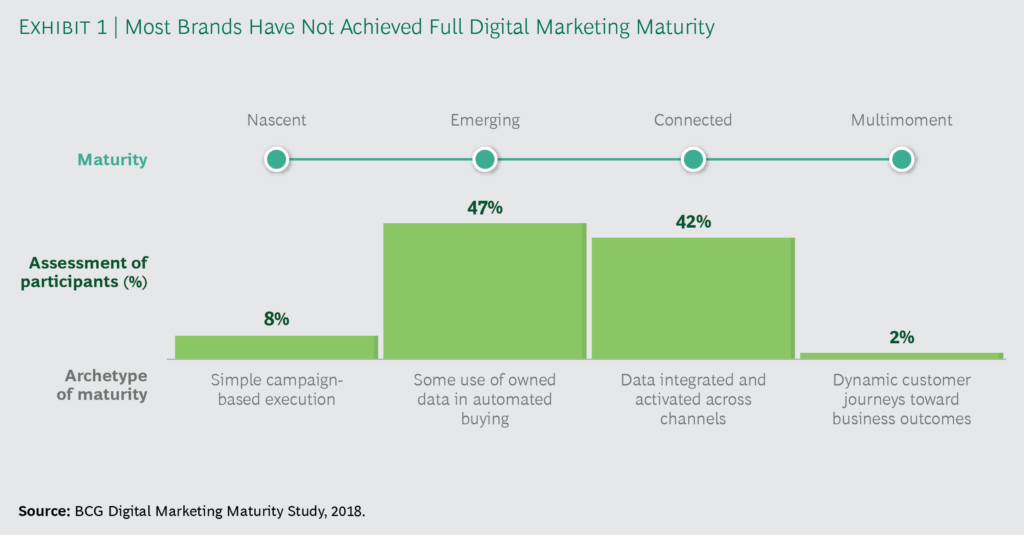“We know personalization is important.”
We hear this quite often in our conversations with customers and prospects. Building more personalized, relevant experiences can have a big impact on revenue and customer engagement—and these companies get that. They know that many, if not all, of the businesses they fear admire have made data-driven personalization a key pillar of their brands. Still, they continue to say:
“There are just so many other things going on right now. It’s not the right time. We’re so busy.”
We don’t doubt this at all. It seems that everyone is busier than ever these days. But it does make us wonder — what exactly is taking up so much time? And if personalization is so important, might it make sense to shift your business priorities accordingly?
Gartner reports that digital transformation is a top corporate goal for 70% of brands, and personalization is one of the most impactful strategies to achieve that goal. Personalization can increase ROI on marketing spend by 5-8x and lift overall sales by more than 10%, according to McKinsey. Personalized product recommendations are unusually effective at driving revenue, lead to repeat visits, increase average order value, and increase conversions from searches, according to a Salesforce study of more than 150 million shoppers and 250 million visits to ecommerce sites.
Gartner reports that digital transformation is a top corporate goal for 70% of brands, and personalization is one of the most impactful strategies to achieve that goal.
Shoppers are hungry for customization too. They’re overwhelmed by choices in the digital space and eager for any guidance brands can provide. According to a survey by Infosys, 78% of customers say they’d be “more likely to purchase from a retailer again if they provided offers targeted to their interests, wants, or needs.”
Think again about those companies you fear admire. Amazon drives 30% of overall site traffic from personalized recommendations. Netflix drives 80% of views from personalized recommendations. Starbucks saw a 300% increase in marketing effectiveness after adopting a real-time personalization engine to provide individualized offers to customers through their app.
Sounds pretty good, doesn’t it? Now how can your company see similar results?
Building more relevant and personalized experiences has a few components. It requires synthesizing your enterprise and behavioral data to gain quantitative insight into customer journeys (online and off). It requires leveraging the latest advancements in design and UX. And it requires using AI and machine learning to deliver data-driven, individually customized recommendations for products, content, and other offers to your users.
We find many businesses are drawn to the design and UX part. We don’t blame them — that’s the fun stuff. And if it looks slick enough it must work, right? Where companies tend to get stuck is in figuring out how exactly to get the most relevant products and content to fill those wireframes. How, exactly, can they reconcile all those terabytes of customer data, in who-knows-how-many different locations, to produce recommendations for each customer?
If you’re in this boat, you’re not alone.
A huge majority of marketers plan to undertake personalization initiatives: according to a survey by performance marketing agency Merkle, 86% of marketers have budgets for personalized messaging initiatives and 89% have the “organizational structure” in place to pull off “personalized multi-channel marketing plans.”
Too often, though, these plans don’t stick.
Gartner predicts that 80% of marketers who have invested in personalization will have dropped the ball within five years. The stat is alarming, but perhaps unsurprising for anyone who has attempted a large-scale personalization effort at their organization.
Technology is one of the biggest obstacles for many businesses. More than half of customer management executives report they don’t have the necessary technology to manage customer and prospect data, according to research by Forrester. The amount of customer data continues to increase, but brands increasingly are losing control of this information. Only 35% of executives from “top-performing customer data management organizations” were able to “accurately track customer journeys in an omnichannel experience,” and “less than a quarter… said they were able to conduct real-time analysis on their customers,” reports MarTech Today.
The good news is that you don’t have to tackle this problem alone. There are tools and frameworks that can help you accelerate much faster than you would alone.
Syntasa’s Customer Intelligence Platform enables brands to unify enterprise and behavioral data, stitch together each customer’s history using a comprehensive identify graph, and apply custom AI and ML models to power data-driven omnichannel personalized recommendations at scale. Because Syntasa sits natively within your big data architecture, there’s no need to add another SaaS platform to your marketing stack or transfer your data to yet another silo.
We also hear from some conversations that they’re worried they’ve waited too long to adopt personalization — that other companies are likely so far ahead in their journey that there’s no use in getting started now. But there’s no time like the present. Syntasa enables your team to deliver value quickly, without having to wait on data science or IT resources or hire a new (and expensive team).
Plus, chances are, you’re not as far behind as you think.
BCG reports that most brands have actually not yet achieved full digital maturity, with only 2% of brands having established “dynamic customer journeys toward business outcomes.”

If you’ve realized you’re not too busy to start now, there’s still a chance to move ahead of your competition. But every day you wait is another day you risk falling further behind.
Ready to get started with Syntasa? Start a free trial today!

